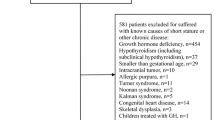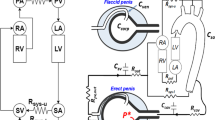Abstract
The aim of this study was to determine the average penile length of a group of healthy, young Turkish men, and to investigate the relationship between penile length and somatometric parameters in the same group. The flaccid and stretched length and circumference of the penis was measured in a group of 2276 physically normal, young men. The correlation between penile length and weight, height and body mass index (BMI) of the participants was determined by Pearson's analysis. The mean age of the participants was 21.1±3.1 (18–39) years. The mean flaccid, fully stretched and circumferential length of the participants' penises were 8.95±1.04, 13.98±1.58 and 8.89±0.86 cm, respectively. There was a significant relationship between all of these variables (P<0.01). Although weak positive correlations were found between the mean circumference length and BMI, there were no correlations between both the flaccid and stretched lengths and BMI. The penile length must be known to be able to determine the abnormal penile sizes and to make convenient decisions in the counseling and/or treatment of people with short penis concerns. Our study provides mean penile lengths in a large sample of healthy, young Turkish men, and the penile dimensions were found to be weakly correlated with somatometric parameters.
This is a preview of subscription content, access via your institution
Access options
Subscribe to this journal
Receive 8 print issues and online access
$259.00 per year
only $32.38 per issue
Buy this article
- Purchase on Springer Link
- Instant access to full article PDF
Prices may be subject to local taxes which are calculated during checkout
Similar content being viewed by others
References
Diseth TH, Bjordal R, Schultz A, Stange M, Emblem R . Somatic function, mental health and psychosocial functioning in 22 adolescents with bladder exstrophy and epispadias. J Urol 1998; 159: 1684–1689; discussion 1689–1690.
Mondaini N, Ponchietti R, Gontero P, Muir GH, Natali A, Caldarera E et al. Penile length is normal in most men seeking penile lengthening procedures. Int J Impot Res 2002; 14: 283–286.
Sengezer M, Ozturk S, Deveci M . Accurate method for determining functional penile length in Turkish young men. Ann Plast Surg 2002; 48: 381–385.
Mehraban D, Salehi M, Zayeri F . Penile size and somatometric parameters among Iranian normal adult men. Int J Impot Res 2007; 19: 303–309.
Schneider T, Sperling H, Lummen G, Syllwasschy J, Rubben H . Does penile size in younger men cause problems in condom use? a prospective measurement of penile dimensions in 111 young and 32 older men. Urology 2001; 57: 314–318.
Aslan Y, Atan A, Omur Aydin A, Nalcacioglu V, Tuncel A, Kadioglu A . Penile length and somatometric parameters: a study in healthy young Turkish men. Asian J Androl 2010; 13: 339–341.
Shah J, Christopher N . Can shoe size predict penile length? BJU Int 2002; 90: 586–587.
Spyropoulos E, Borousas D, Mavrikos S, Dellis A, Bourounis M, Athanasiadis S . Size of external genital organs and somatometric parameters among physically normal men younger than 40 years old. Urology 2002; 60: 485–489; discussion 490–481.
Ponchietti R, Mondaini N, Bonafe M, Di Loro F, Biscioni S, Masieri L . Penile length and circumference: a study on 3,300 young Italian males. Eur Urol 2001; 39: 183–186.
Ghanem H, Shamloul R, Khodeir F, ElShafie H, Kaddah A, Ismail I . Structured management and counseling for patients with a complaint of a small penis. J Sex Med 2007; 4: 1322–1327.
Alter GJ . Augmentation phalloplasty. Urol Clin North Am 1995; 22: 887–902.
Wylie KR, Eardley I . Penile size and the ‘small penis syndrome’. BJU Int 2007; 99: 1449–1455.
Kuzgunbay B, Turunç T, Güvel S, Özkardeş H . The average penile size of the Turkish men and their opinions about the penile size. Turk J Urol 2007; 33: 290–293.
Francken AB, van de Wiel HB, van Driel MF, Weijmar Schultz WC . What importance do women attribute to the size of the penis? Eur Urol 2002; 42: 426–431.
Son H, Lee H, Huh JS, Kim SW, Paick JS . Studies on self-esteem of penile size in young Korean military men. Asian J Androl 2003; 5: 185–189.
Vardi Y, Gruenwald I . The status of penile enhancement procedures. Curr Opin Urol 2009; 19: 601–605.
Murtagh J . The ‘small’ penis syndrome. Aust Fam Physician 1989; 18: 218, 220.
Li CY, Kayes O, Kell PD, Christopher N, Minhas S, Ralph DJ . Penile suspensory ligament division for penile augmentation: indications and results. Eur Urol 2006; 49: 729–733.
Bondil P, Costa P, Daures JP, Louis JF, Navratil H . Clinical study of the longitudinal deformation of the flaccid penis and of its variations with aging. Eur Urol 1992; 21: 284–286.
Wessells H, Lue TF, McAninch JW . Penile length in the flaccid and erect states: guidelines for penile augmentation. J Urol 1996; 156: 995–997.
Ting TH, Wu LL . Penile length of term newborn infants in multiracial Malaysia. Singapore Med J 2009; 50: 817–821.
Gabrich PN, Vasconcelos JS, Damiao R, Silva EA . Penile anthropometry in Brazilian children and adolescents. J Pediatr (Rio J) 2007; 83: 441–446.
Chen J, Gefen A, Greenstein A, Matzkin H, Elad D . Predicting penile size during erection. Int J Impot Res 2000; 12: 328–333.
Loeb H . Harnrohrencapacitat und Tripperspritzen. Munch Med Wochenschr 1899; 46: 17.
Burgu B, Aydogdu O, Tangal S, Soygur T . Circumcision: Pros and cons. Indian J Urol 2010; 26: 12–15.
Smith DP, Rickman C, Jerkins GR . Ultrasound evaluation of normal penile (corporeal) length in children. J Urol 1995; 154 (2 Part 2): 822–824.
Kinsey A, Pomeroy W, Martin C . Sexual Behaviour in the Human Male. WB Saunders Co.: Philadelphia, PA, 1948.
Ajmani ML, Jain SP, Saxena SK . Anthropometric study of male external genitalia of 320 healthy Nigerian adults. Anthropol Anz 1985; 43: 179–186.
Awwad Z, Abu-Hijleh M, Basri S, Shegam N, Murshidi M, Ajlouni K . Penile measurements in normal adult Jordanians and in patients with erectile dysfunction. Int J Impot Res 2005; 17: 191–195.
Promodu K, Shanmughadas KV, Bhat S, Nair KR . Penile length and circumference: an Indian study. Int J Impot Res 2007; 19: 558–563.
Author information
Authors and Affiliations
Corresponding author
Ethics declarations
Competing interests
The authors declare no conflict of interest.
Rights and permissions
About this article
Cite this article
Söylemez, H., Atar, M., Sancaktutar, A. et al. Relationship between penile size and somatometric parameters in 2276 healthy young men. Int J Impot Res 24, 126–129 (2012). https://doi.org/10.1038/ijir.2011.53
Received:
Revised:
Accepted:
Published:
Issue Date:
DOI: https://doi.org/10.1038/ijir.2011.53
Keywords
This article is cited by
-
#Penisenlargement on Instagram: a mixed-methods study
International Journal of Impotence Research (2022)
-
Cosmetic penile enhancement surgery: a 3-year single-centre retrospective clinical evaluation of 355 cases
Scientific Reports (2019)
-
Outcomes of variation in technique and variation in accuracy of measurement in penile length measurement
International Journal of Impotence Research (2018)
-
A comprehensive, prospective study of penile dimensions in Chinese men of multiple ethnicities
International Journal of Impotence Research (2014)



